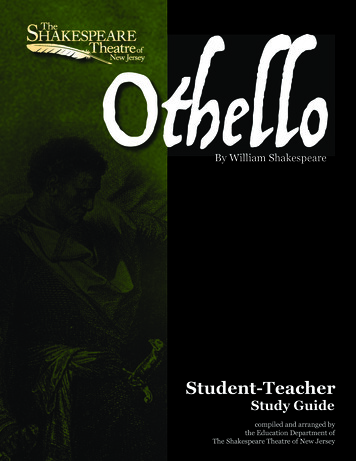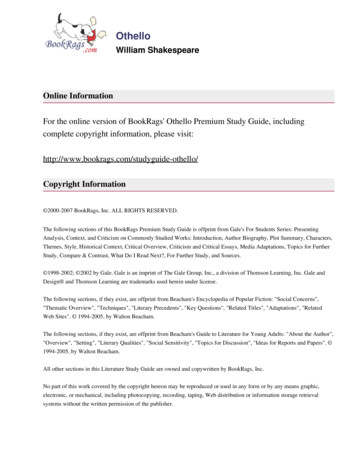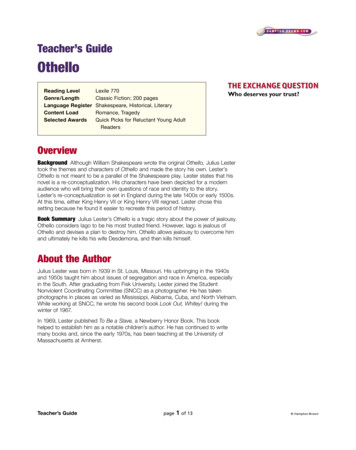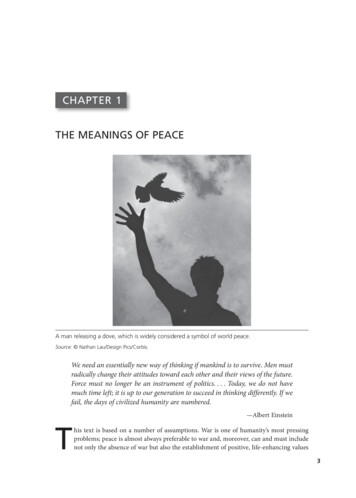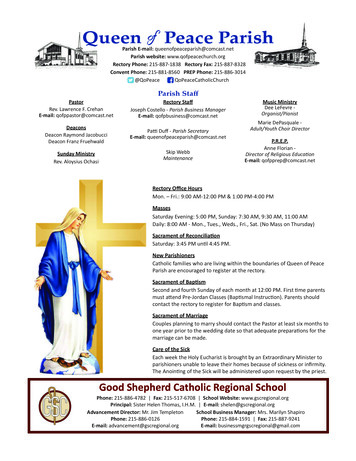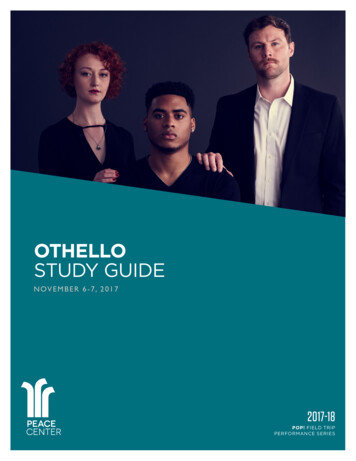
Transcription
OTHELLOSTUDY GUIDEN OV E M B E R 6 - 7 , 2 0 1 72017-18POP! FIELD TRIPPERFORMANCE SERIES
Othello:A Guide for TeachersThe Warehouse Theatre2017 Educational Touring ProductionFor more information, contact Mallory Pellegrino,Director of Educationmallory@warehousetheatre.com
Hello Educators!Each year, The Warehouse Theatre works with dozens of schools inSouth and North Carolina, bringing customized workshops tostudents in grades 3 – 12. We support English Language Art, Theatre,and Literature standards, by bringing the actor’s approach toShakespeare to the students, empowering them to speak thespeeches and embody the words as well as learn how to applythese tools to their own experience. Through our curricular strategiesand arts-integrated approach, we celebrate inclusion, criticalthinking, teamwork, process, and problem solving.Shakespeare continues to be an important part of the curriculum inmost states, and regardless of changes in standards and bestpractices, we believe that interacting with these complex textsteaches valuable skills which have an impact on young students’lives beyond the ELA or theatre classroom. Critical thinking, closereading, looking at situations from different perspectives, examiningsocietal and personal morals and motives, encountering anddeciphering structure, building vocabulary and cultural references –Shakespeare brings this and much more to the young scholar!It is in this spirit that we have designed this study guide – intended foreducators in middle and high schools to use as a tool to enhancestudent comprehension and enjoyment of The Warehouse Theatre’sproduction of William Shakespeare’s Othello. The exercisescontained in this guide are designed to align with the curricular2
goals in the middle and high school English Language Arts,Literature, and Theatre classroom. This guide may be used as asupplement to classroom study of this text—and is best used in thecontext of attending The Warehouse Theatre’s touring production ofOthello. Please feel free to “pick and choose” articles and activitiesas they complement your work in the classroom!This study guide is divided into Three Sections for your convenience:THE BASICS for a general overview and knowledge of the play,THE BARD for information about Shakespeare’s life and time,and THE BONUSES for experiential and more advanced activities.We hope you will find this guide useful, and that you will let us knowwhat information, topics for discussion, and exercises you integrateinto your curriculum. Please feel free to let us know what you wouldlike for us to include in future study guides or resources.Thank you for your support of The Warehouse Theatre! If we cansupport your curriculum in any additional ways, please contact meat mallory@warehousetheatre.comAll my best,Mallory PellegrinoDirector of Education3
TABLE OF CONTENTSTHE BASICS:Plot Synopsis6A Simple Structure in Shakespeare Plays8Characters in Othello10Character Quotes11Major Themes and Motifs12Systems of Oppression in Othello13A Glossary of Terms17Famous Othellos Throughout History18What Makes a Tragedy?20THE BARD:Shakespeare's Life as a Play24Shakespeare's England26Why Do We Study Shakespeare?32THE BONUSES:WHT's Production Concept and Look Book36Explore and Activate the Text38The Three Ds: Disclosure, Discovery, Decision41Appearance vs. Reality, Public vs. Private42The Art of Lying in Shakespeare43Audience Etiquette and Experiencing Theatre44Further Educational Materials474
THE BASICS5
OTHELLO: A SYNOPSISThe play begins in Venice, in the middle of the night. Iago andRoderigo are meeting to discuss their hatred of Othello. Iago hatesOthello because he promoted Cassio to lieutenant over Iago, andRoderigo is a heartbroken, failed suitor of Desdemona’s. Theydecide to wake up senator Brabantio with the news that hisdaughter, Desdemona, has secretly married Othello, the general ofthe Venetian army and a Moor. Brabantio calls an emergencymeeting of the senate, where Othello and Desdemona make a casefor their mutual love and defy the objections of a marriage betweena black man and white woman. The Duke of Venice sides withOthello, who is then called to defend Venice from attacks of theTurkish fleet.The action of the play then moves to Cyprus, where we learn Othellohas just defeated the entire Turkish fleet. Desdemona, Iago, andEmilia have just arrived in Cyprus as well. The honeymoon phasedoesn’t last long, as Iago doesn’t waste any time enacting his evilplan to convince Othello that Desdemona is disloyal and having anaffair with Cassio, bringing about both of their downfalls.The more Othello trusts Iago, the more he distrusts Desdemona andCassio. His jealousy begins to rule him. Othello reaches his breakingpoint after Iago tell him he has seen the handkerchief Othello hadgiven Desdemona, claiming that Desdemona had given Cassio thehandkerchief as a token of her love. When Desdemona cannotproduce the handkerchief, Othello flies into a rage. After he leaves,Emilia suggests that Othello is jealous, but Desdemona brushes thisoff, swearing he has nothing to be jealous about. In actuality, Emiliahas given Iago the handkerchief.To further seal Othello’s fate, Iago plans a conversation with Cassio6
while Othello hides to listen. Instead of discussing Desdemona, asOthello believes, Iago asks Cassio about Bianca, the courtesan inlove with him. Enraged by what he hears, Othello asks Iago to killCassio and leaves to meet his wife.Instead of killing Cassio himself, Iago tricks Roderigo into trying to killCassio, saying it is the only way Roderigo can win Desdemona’slove . When both men are wounded, Iago enters and kills Roderigoto hide the truth. Then, he pretends to mourn the death of his friend.Meanwhile, Othello meets Desdemona in their bed chamber.Although Desdemona protests her innocence, Othello’s jealousy hasconsumed him, and he smothers his wife.Emilia enters to deliver news of Roderigo’s death, raising the alarmonce she sees the murdered Desdemona. Realizing what hashappened, Emilia denounces Iago, and he stabs her and flees.Once Iago is brought back, the whole truth is revealed.Overwhelmed by his own guilt at what he has done, Othello killshimself. Iago is arrested and taken away.7
A SIMPLE STRUCTURE IN SHAKESPEARE’S PLAYS(SOMETHING YOU CAN COUNT ON)According to Louis Fantasia, scholar and author of InstantShakespeare, in all of Shakespeare’s plays you can count on the plotincluding four elements:ONE : The world (or worlds) of the play begin in some sort of disorderor chaos as a result of some inciting incident.TWO: Some figure of authority (a king or queen, prince, duke,parent) makes a decision that will have a significant impact on thelives of the other characters in the world of the play.THREE: The dramatic or rising action of the play unfolds as theaffected characters in the world of the play take some action inresponse to the decision made by the authority figure. Often, this willlead them on a journey to a “middle” world of the play that is indirect contrast or juxtaposition to the world of disorder or chaos thatstarts the play.FOUR: The actions taken by the affected characters force some sortof climax or resolution based on the decision made by the figure ofauthority. In a comedy, this resolution comes in the form of multiplemarriages. In a tragedy, it comes in the form of multiple deaths.Ultimately, this resolution restores order to the first world.8
TERMS TO KNOW: Plot: Events that make up a story. Inciting incident: The event or decision that begins a story’sproblem. Dramatic action / Rising action: A series of events that buildtoward the point of greatest interest. Climax: A decisive moment or turning point in a storyline. Resolution: The action of solving the story’s problem.ACTIVITIES:1. Recognize It: Identify these four structural elements in Othello.2. Support It: Find textual evidence (i.e. direct quotations) thatshow each of the four elements.3. Visualize It: Create a chart, illustration, or some visual aid torepresent your findings.4. Physicalize It: Construct a tableau (frozen picture made withyour body) to represent each of the four phases. Put them alltogether in a physical slide show.5. Go Further: Apply this test to another of Shakespeare’s plays tosee if it holds up. Compare your results.9
CHARACTERS IN OTHELLO: Othello—a Moor, General in the service of VeniceDesdemona—his wife, a Venetian ladyBrabantio—her father, a Venetian senatorIago—Othello’s ensignEmilia—Iago’s wife and Desdemona’s waiting womanCassio—Othello’s lieutenantRoderigo—suitor of Desdemona, a Venetian gentlemanBianca—a courtesan in Cyprus in love with CassioDuke of VeniceSenatorsMontano—a Venetian official in CyprusGratiano—Brabatio’s brotherLodovico—Brabantio’s kinsman and Desdemona’s cousinVarious Officers, Gentlemen, Sailors, and MessengersTHINK LIKE A DIRECTOR:In The Warehouse Theatre’s touring productions, we are oftenlimited to a 6-7 actor cast. This means that actors have to playmultiple roles and oftentimes minor characters are cut. Given thelist above and what you know about the story of Othello, whichcharacters do you think you could cut? Which characters do youthink could be doubled with another character?10
CHARACTERS, ACCORDING TO THEMSELVES:Othello My noble Moor is true of mind and made of no such basenessas jealous creatures are. (Desdemona, III, iv) I will be found most cunning in my patience but – dost thouhear? – most bloody. (Othello, IV, i) Is this the noble Moor whom our full senate call all in allsufficient? Is this the noble nature whom passion could notshake? (Lodovico, IV, i) Speak of me as I am one that loved not wisely, but toowell; of one not easily jealous but being wrought, perplexedto the extreme. (Othello, V, ii)Iago I am not what I am. (Iago, I, i)I follow him to serve my turn upon him. (Iago, I, i)And what’s he then that says I play the villain? When thisadvice is free I give and honest (Iago, II, iii)When devils will the blackest sins put on they do suggest atfirst with heavenly shows as I do now. (Iago, II, iii)I do think it is their husbands’ faults if wives do fall. (Emilia, IV,iii)Desdemona She loved me for the dangers I had passed, and I loved herthat she did pity them. (Othello, I, iii) That I did love the Moor to live with him, my downrightviolence and scorn of fortunes may trumpet to the world.(Desdemona, I, iii) Look to her, Moor, if thou hast eyes to see; she has deceivedher father, and may thee. (Brabantio, I, iii) Has she forsook so many noble matches, her father, and hercountry, and her friends, to be called whore? (Emilia, IV, ii)11
MAJOR THEMES AND MOTIFSTheme is defined as the central idea in a piece of writing or otherwork of art.Motif is defined as a distinctive feature or dominant idea in anartistic or literary composition.In drama, the central theme is usually an intrinsic or essential ideasurrounded by several more literal or representative motifs. Below isa list of words representing either themes, dominant images, ormotifs from Othello.PrejudiceReputation & HonorMen vs. WomanRaceLove: Romantic &BrotherlyHuman NatureProof & JudgmentAppearance vs.RealityAction vs. ReactionThe HandkerchiefTruth vs. LiesWaterJealousy & TrustBlack vs. WhiteThe DevilRank/StatusACTIVITY: Themes and motifs often help directors and designerschoose their concept.1. Recognize It: Choose what you believe to be the one centraltheme in Othello.2. Support It: Find at least three lines of text to support your chosentheme.3. Visualize It: Assign students different elements of design (set,costumes, lights, sound). Collect visual research that supports yourtheme. How would this research impact your design?4. Physicalize It: Present your theme and research to the class. Readyour lines of text aloud. Focus on highlighting your particulartheme.5. Go Further: Choose another theme but keep the same chosenthree lines of text. Can you make your theme work for these lines?12
SYSTEMS OF OPPRESSION IN OTHELLO:CHALLENGES FOR 21ST CENTURY DIRECTORSThoughts from Directors Anne Tromsness and Maegan AzarWhen we were hired to co-direct Othello, one of the firstconversations we had was about how fraught this text might be for a 21stcentury Southern audience comprised primarily of young people. We livein a culture where racism, misogyny, and other forms of inequity andsystems of oppression are at the front of most discussions about ournation’s greatest challenges and our identity. Producing a play whichsimultaneously points up inequity and also normalizes it offers specialchallenges.Theatre has the capacity to promote conversation, transformthought, and to give its audiences an opportunity to examine their ownpoints of view, positions, privileges, and prejudices. Theatre does thisbecause it employs - simultaneously - distance for its audience through(primarily) fictional events and characters, while making the watcherswitnesses, and therefore complicit in the events of the play and theactions of the characters. Good theatre, while reflecting the veryintentional choices of directors, actors, and designers, also doesn’tpreach or dictate the audience’s response to it. It is in this free and openexchange between audience and performance that theatre wieldsboth the power of transforming thought, and the potential formisunderstanding and misinterpretation.We asked ourselves in the early days of our process - andthroughout - what statement(s) are we making with this play right here,right now? How do systems of oppression play out in the text, and in ourproduction specifically? How can we honor the text, as well as our ownpoints of view, without imposing them on the audience? But also, howcan we make sure we don’t do harm to the populations that areaffected by the systems of oppression in the play?As we moved forward, we were moved by moments in the text,quotes and passages, actions, which both resonated with us in terms ofcontem
OTHELLO: A SYNOPSIS The play begins in Venice, in the middle of the night. Iago and Roderigo are meeting to discuss their hatred of Othello. Iago hates Othello because he promoted Cassio to lieutenant over Iago, and Roderigo is a heartbroken, failed suitor of Desdemona’s. They decide to wake up senator Brabantio with the news that his
